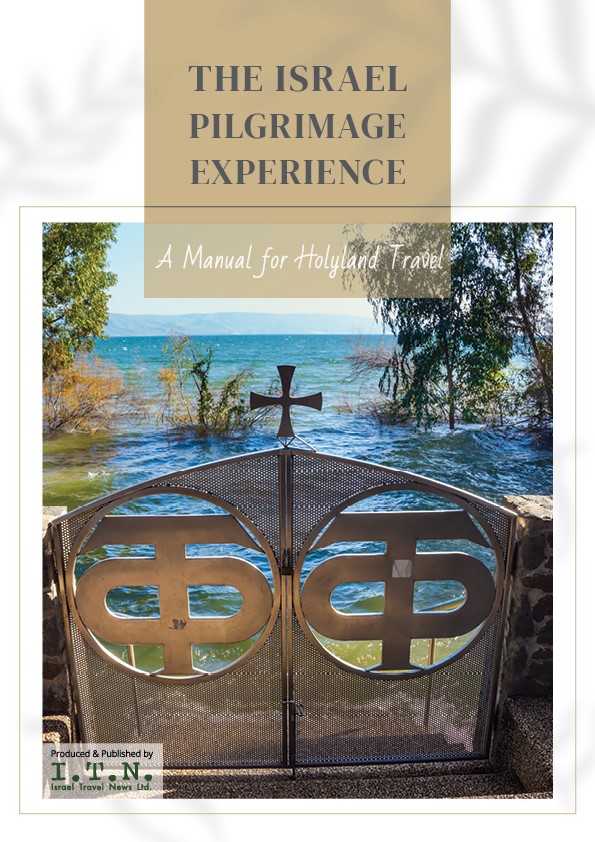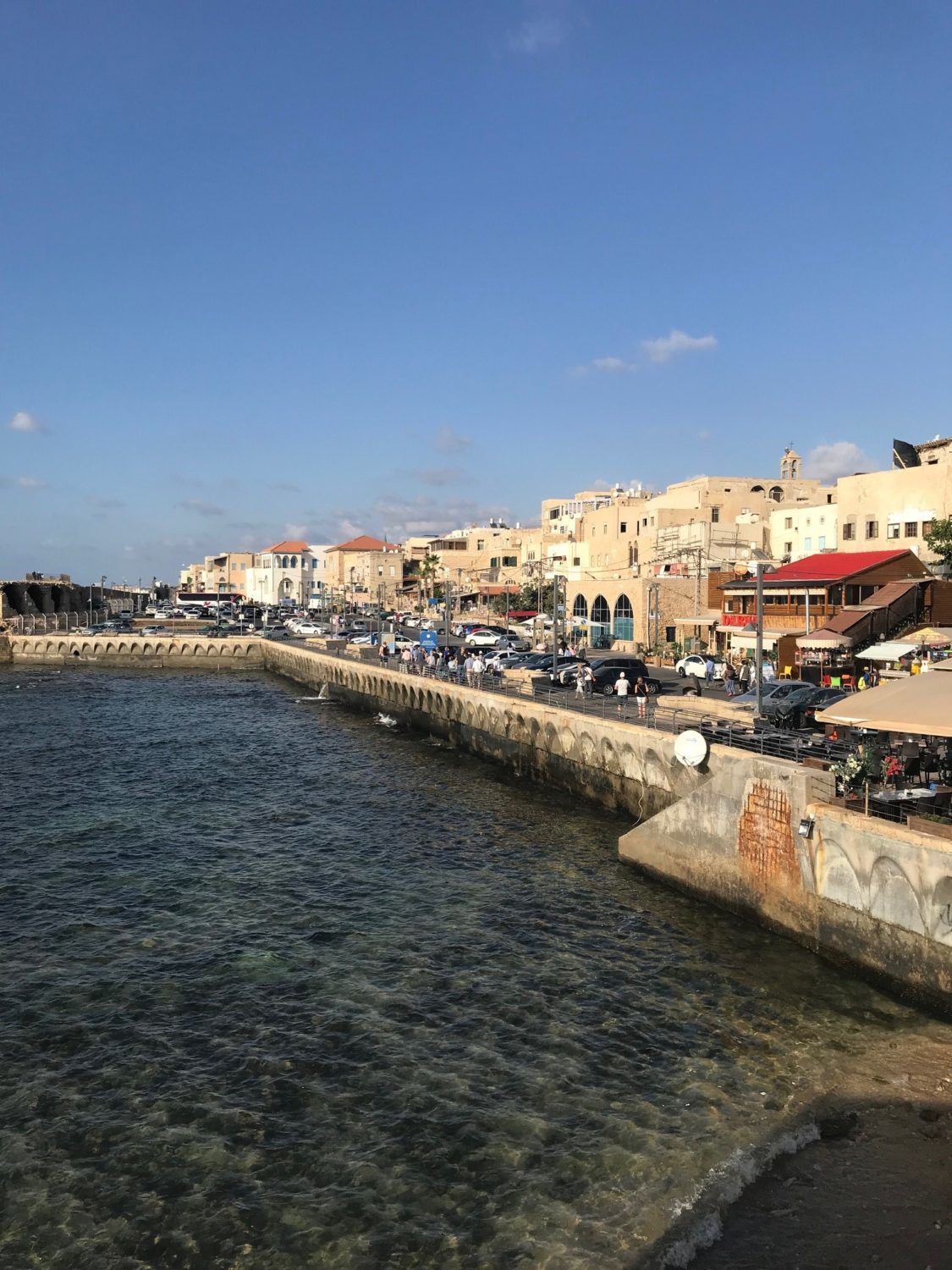
From the peak of the north to the depths of the south, the compact country boasts a diversity of regions, bursting with distinctively unique characteristics and the opportunity of luxury experiences. With the Jewish holidays clearing a gap in the calendar, I switched my desk for the road to venture on an exploration of indulgent discoveries.
Day One – Zikhron Ya’akov
Approximately 35 kilometers south of Haifa, at the southern end of Carmel Mountain, overlooking the Mediterranean Sea, is Zikhron Ya’akov – a small town with a big history, notably on the subject of Israeli winemaking. With over 13,500 acres of wine vineyards providing grapes to Israel’s 40 wineries (and 250 boutique wineries), Zikhron Ya’akov has become an historical region renowned for its wine production.
Exploring History at Carmel Winery
Carmel Winery is the largest wine producer in Israel, with roots dating back to 1882, the time of the region’s founding by Jewish Romanians. The area became prosperous after a visit in 1887 from Baron Edmond de Rothschild, a banker from Paris and owner of Bordeaux winery Château Lafite. In 1895, Carmel Winery became an exporter of wines produced from its Rishon LeZion and Zikhron Ya’akov wineries, built in 1890 and 1892, respectively, and to this day the winery remains Israel’s largest exporter, with 15 million bottles produced a year, around 15-20 percent of which are sold internationally. The company is symbolic to the land of Israel and holds prestigious significance in that it once served as the workplace for three Israeli Prime Ministers – David Ben-Gurion, Levi Eshkol and Ehud Olmert.
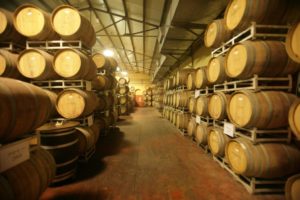
The winery maintains much of its original charm and houses a small theater, showcasing a film on the country’s wine industry (offered in English, Russian, Chinese and Hebrew); the vat room, with lines of refurbished cement tanks, and grand private tasting room. A personal highlight was venturing into the underground cellar, an atmospheric space with low lighting and rows of old piled barrels. Across from the main building is the Carmel Wine & Culture center, which was established 10 years ago as an extension of the historical barrel room, delicately merging present day appeal with decades of history.
The well-maintained barrel room contains smartly stacked rows of French barrels as far as the eye can see, each nurturing hundreds of liters of maturing wine. “The barrels are only used for storing two to three harvests of wine as they become less aromatic if left any longer,” explains Carmel Wine and Culture Manager, Valerie Hecht. A temperature controlled room containing mammoth 5,000 barrel tanks is adjoined. “It’s quite extraordinary to think that even a century ago, without the luxury of today’s technology, we were able to put into motion the processes required to make wine, throughout each intricate stage. The introduction of double jacketed stainless steel vats in the 1960s further transformed the winemaking process into what we see today.”
I gathered around the central wooden table in the Carmel Wine & Culture center to taste a rainbow of wines and assess my connoisseur abilities. The Appellation Gewurztraminer 2016 – a semi dry white wine made from grapes in the Judean Hills vineyards, is aromatic with a hint of sharpness. The 2015 Ha’Nadiv Valley red, from the Private Collection, provided fruity underlying tones; whilst the 2003 Mt. Amasa from Yatir Winery in Arad – owned by Carmel Winery – is more immediate and intense in its flavors. “This wine is aged for approximately one year in a small oak barrel and sold after two years of additional aging in the bottle,” explains Hecht. The front-runner is the 2 Vats Rose, a 2016 dry wine blending fruity notes of strawberry and red grapefruit, a divine companion for a sun soaked afternoon. The wine was the recipient of the gold medal and trophy for the 2016 Citadelles Du Vin competition in Bordeaux, a deserving champion.
Carmel winery offers around four tours per day, five days a week, from experienced guides within the industry. “We cater to a wide market, both incoming and domestic, with a lot of guests from North America, China and Europe,” outlines Hecht. Tours include a one hour classic tour and tasting and an extended workshop tour, featuring a visit to the barrel sites and private tasting experience, accompanied by locally produced cheeses.
Tishbi Winery: A Tasteful Afternoon
In 1882, the Tishbi family was commissioned by Baron Edmund de Rothschild to plant one of Israel’s first modern vineyards. Fast forward to 1984 and Tishbi Winery was inaugurated by Jonathan Tishbi and continues as a family run enterprise to this day, traversing decades of experience in the wine making industry. Located between Binyamina and Zikhron Ya’akov, the site produces one million bottles of wine a year, 20 percent of which are exported.
The visitor’s center houses a magnificent distillery from Cognac in France, a one-of-a-kind in the Middle East, which General Manager and winemaker, Golan Tishbi, uses to produce an award winning ten year aged brandy every few years. The center also houses a second level archive of wines. “We spent 17 years really perfecting the quality of our product before opening the visitor’s center to the public. This remains our focus and extends into our careful selection of shops and eateries, which stock our wines across Israel” says Golan. “We currently offer around 18 types of wine and we invite our guests to sample a selection hand in hand with a chocolate tasting.”
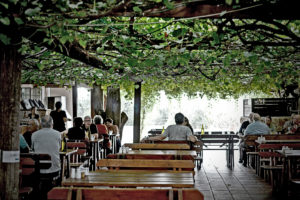
I take a seat at the high top square bar to sample from a selection of wines. “Our grapes are sourced from all over Israel, from Sde Boker all the way to the Golan Heights, all of which have the best vine-growing conditions,” explains Oshra Meltzer, office manager and public relations and export management at Tishbi. I smell and swirl the 2012 Estate Cabernet Sauvignon before taking a sip. The 12 month aged wine reveals a mixture of fruity notes and a light sweetness. This is followed by the 2012 Malbec, a single vineyard wine with a sharper aftertaste. “When grapes are picked from a single vineyard, the taste is isolated as the fruit has grown from the same soil. You can really taste the difference.” I also taste the Ruby Cabernet, a 2012 plum colored wine with a powerful aroma, which is subtle on the palate. Tishbi is the official importer of luxury French chocolatier Valrhona and has an exquisite display of treats from the company’s extensive catalogue, all of which encompass a distinctive flavor: The Abinao 85 percent offers a fierce intensity of cocoa, a satisfying blend of bitter with a sweeter ending; the Manjari 64, a less tart concentration with a fruitier flavoring; and cream Blond Dulcey, a heavenly mélange of biscuit and shortbread in one extravagant bite.
Aside from the winery, the on-site bakery churns out fresh goods from its own unique combinations of milled flour. The welcoming smell allures you in, where you can watch the rising bread bake in the imported wood burning oven from France. Additionally, Tishbi has a kosher dairy restaurant with a breakfast and lunch menu, and an American style food truck which caters a barbeque every Friday.
We move to the restaurant for lunch, prepared by Austrian master chef, Gunther Biedermann. Perched on a bench in the outdoor porch, nuzzled beneath a canopy of intertwined vines, I pour over the menu, extensive and well thought out across a choice of starters, pizzas, pastas, fish dishes and salads. The grilled beer pastry, topped with camembert cheese and a blob of wine jelly, is very special; the triangular cuttings a flawless sweet and savory parcel. The poached asparagus salad is equally as satisfying, with its combination of capers, pickled dill cucumbers, a boiled egg, mint, parsley and chopped shallots, served alongside roasted potato wedge chunks. A basket of the bakery’s freshly baked bread is also served with a spread of gourmet fruit wine Jelly, produced by Oshri Tishbi, daughter of Jonathan, who created her own line of products entitled: “Fine Foods by Oshra Tishbi”.
The experience was a harmonious balance of informative learning in tranquil surroundings, a welcoming start to a pampering respite in Israel.
Tours are offered in English, French and Hebrew. Tishbi Winery is open Sunday – Friday.
Ancient Findings in Caesarea
The ancient town of Caesarea is a picturesque region of Israel, founded by King Herod in the first century BCE, located 20 minutes south of Zikhron Ya’akov by car. Having exchanged ownership throughout the ages – from the Romans to the Fatimids, the Crusaders, the Ottomans, the British (under their Mandate of Palestine) and finally to the State of Israel, – Caesarea sits on Israel’s coastal plain and is an area of ancient fascination, archaeological discoveries and a magnitude of activities.
We reach the region just in time to explore the unearthed wonders contained within Caesarea National Park, including the restored Roman 100 meter amphitheater, – the oldest of its kind east of the Mediterranean – and the Promontory Palace to its southern end, which underwent excavations between 1990 and 2001. On display are the remains of the hippodrome, a structure rebuilt during the 2nd century AD and in part utilized as an amphitheater for gladiators, as well as the breathtaking remains of the Caesarea Columns, amid a scattering of other ancient remnants excavated during the 1950s and 1960s.
The experience is an excellent lesson in history, with tales of bygone eras hinted throughout the entirety of its landscape. This area extends into Caesarea’s Harbor, lined with quaint galleries and a selection of restaurants, a significantly historical landmark connecting to the sea.
Helena: Modern Dining on Historic Land
A short walk along Caesarea’s port is Helena restaurant, named after the Greek Goddess, daughter of Zeus and Leda, and a symbol of perfect beauty. The exposed stone décor amid other classical elements unifies with the ancient backdrop, which can be seen across each tier of the restaurant. The owners of Helena, Chef Amos Sion and his partner Uri Jeremias, are both renowned for their outstanding service within the culinary field. Sion’s roots for fine cuisine sprouted from a young age, when he would cook for his family, later entering the study of gastronomy, working among Israeli chefs, such as Yankale Schein and Yonatan Roshfeld and furthering his learning in Alsace Lorraine.
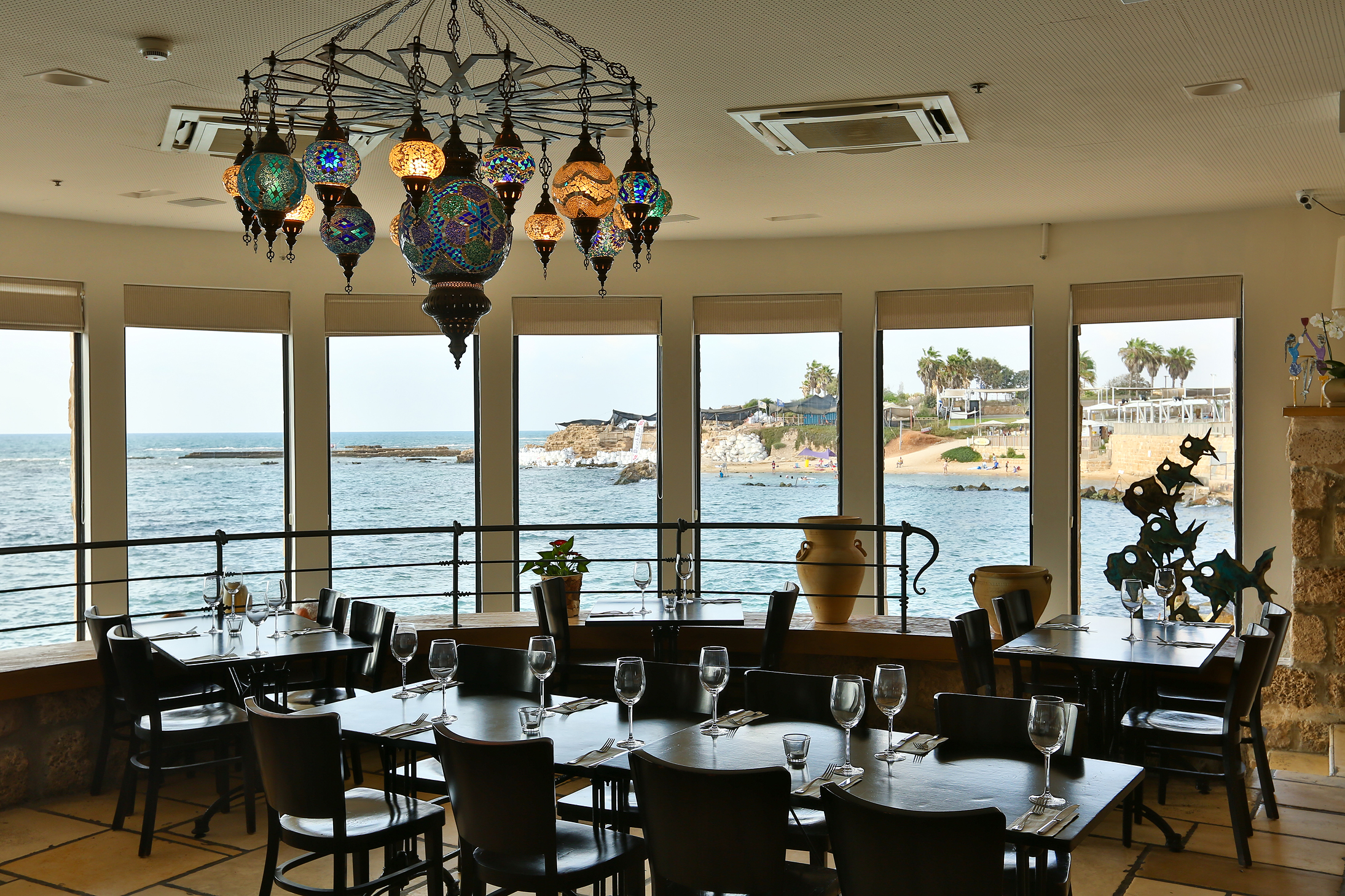
The menu infuses Israeli Mediterranean cuisine with tastes from Europe for an inventive repertoire, fashioned from locally sourced ingredients, which are reflective of the season. Darkness has set by the time we arrive and our window romantically captures the reflection of waves in the moonlight. We are greeted by Chef Amos, who warmly welcomes us to Helena, before whisking us off to the kitchen to concoct a special tasting menu for the evening. Our appetizer arrives shortly after – grouper sashimi cured in beetroot and arak, balanced carefully on a stack of herb salad, almonds and smoked eggplant cream, amid a stream of parsley oil. The skillfully cured fish is fresh and the ingredients on the whole are an exhibition in both taste and presentation.
A glass of 2015 New Zealand Private Bin Sauvignon Blanc is poured, a powerfully aromatic wine, which pairs well with our first course of smoked pizza bread, topped with drum fish, thinly sliced potato and succulent garlic, prepared in the restaurant’s olive wood stone oven; a harmony of intense textures and rich piquancy.
Next on the menu is a red tuna carpaccio plate, topped with a cucumber-anise sorbet, with clusters of tobiko egg, balancing on sliced radishes. The flavors are delicate, a tartness interacting with the cleansing sorbet for a lustful mingling of tastes. Chef Amos’ union of unconventional ingredients is genius, a special component that comes with dining at Helena and an ignition for dinner table conversation.
We wash down this course with a local Shiraz from the Galilee, a gentle wine with fruity undertones. Before long, Chef Amos appears at our table, to present a cauldron of baked drum fillet on a bed of Italian riso pasta rice, lathered in porcini sauce, with tender mushrooms and a stem of crispy kale.
Dessert was preluded by a glass of Sangre de Toro, from Torres, Spain. A stormy wine, the color of deep cherry, with notes of intense wild berries. A plate stacked with two scoops of homemade tahini Ice cream is brought to us, dowsed in date Syrup, halva threads and melting onto a bed of cinnamon sugar pastry. We attack from top to bottom, pilling each scoop with a helping of layers, allowing the intensity of flavors to settle on the palate – in basic terms, perfection.
Like the Goddess herself, Helena is flawless, a distinctive evening of delectable gastronomy to enlighten all the senses.
A Cultural Breather at the Elma Arts Complex Luxury Hotel
You can’t help but marvel at the silhouette that is the Elma Arts Complex Luxury Hotel, an iconic two-story property built in 1968 by Yaakov Retcher, which curves to hug the land and sea on which it rests. Named the Mivtachim Sanatorium at that time, the building was used for a number of years as a healing facility for Israeli workers, before briefly operating as an Israeli Defense Force base, and then as another hotel – Carmel Gardens – before shutting its doors in the late 1990s.
The building was once again purchased in 2005 by Israel art patron, Lily Elstein, who spent ten years spearheading a spectacular renovation alongside Amnon Rechter (son of Yaakov Rechter) and architect company Ranni Ziss. Despite its brutalist character, designed to seamlessly integrate raw textures and exposed materials, the hotel is warm, elegant and inviting. “It was Lily’s vision to open the hotel as a celebration of art, with performance halls, art studios and exhibitions scattered across the premises,” says Hotel representative and property tour guide Michal Shimony, as she guides me on a tour of the hotel. “The Elma Arts Complex is multi-functional, a place for many special occasions.”
The maze-like corridors double as an open gallery for guests and visitors to explore exhibitions. I find myself by two striking inkjet print paintings from the artist Ilit Azoulay’s “Imaginary Order” series. Spanning two walls, the images utilize a fascinating technique of layering assembled objects, signifying the intricacies of Elma’s renovation. Guests will encounter a tapestry of artistic surprises weaving their way across every nook, blending into a harmony of soothing music that fills the hotel. It’s a special experience for both art connoisseur and cultural explorers.
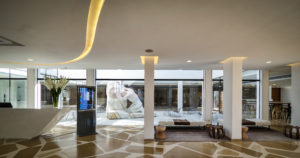
The Cube performance hall was originally designed as a space to hold meetings with union members in the style of the Israeli Parliament and today showcases a calendar of musical performances. “We have something for everyone, from live music to dance performances spread throughout the year.” Elma Hall, the second of the hotel’s performance spaces, once served as a cinema, and has since been transformed into a state-of-the-art 450 seat auditorium. The theater is a breathtaking composition of contrasting shapes, textiles and colors, with a meticulously crafted pipe organ (designed by German organ-builder Philip Klias) floating on a podium above the stage. “This is one of the most advanced performance spaces in Europe in terms of both design and acoustics,” says Shimony. Designed by Artec and Arup Consultants of New York, the theater contains 25 sliding walls that are customizable in layout for each performance. “The seating is the result of extensive work, which involved digging into the ground to build a lower level slope.”
The outdoor grounds are a pleasure to amble. There is a small herb garden, outdoor pool and an expansive courtyard full of artistic surprises, including a paint splattered life size aluminum structure of a male, depicted from Sigalit Landau’s “Endless Solution” exhibition. “The walls of each room were built on a platform to offer shade against direct sunlight and create a sense of intimacy as you soak up the sea and fresh air,” explains Shimony. From my viewpoint, the gaps between room pillars sculpt unique frames of the countryside, forming snug hideaways within the bountiful landscape.
My accommodation for the night is a Deluxe room, one of eight categories available from the 95 rooms on offer. The 35m² space is a respite of uninterrupted tranquility among a minimalist design approach, synchronized to the hotel’s refined grace. Soft oak furnishings, playful textiles, and an opulent walk-in rainfall shower characterize the space, whilst two separate balconies offer shielded privacy to marvel at the spectacular melding of patchwork fields onto the sea.
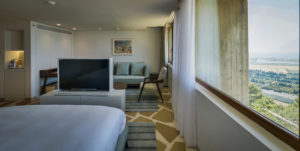
The next morning I’m seated at Ontario, the hotel’s restaurant run by Chef Gil Aviram, alongside pastry chef Sharon Harel. The restaurant’s bravura is reflected in both its cuisine and design – exposed glass cases of finely stacked local wines, exquisite handcrafted furniture embodying classic brutalist elements and timeless gold furnishings for a dash of understated opulence. The buffet breakfast features a multitude of dishes, conceived of locally sourced ingredients. Counters laden with colorful salads, roasted vegetables, plates of sliced cheeses, a piping hot shakshuka, spreads and dips of every category, cereals and fruits, loaded with tempting cakes, sweet Malabi and coffee prepared to your liking. The showstopper of the morning is the knafeh, a Middle-Eastern shredded wheat pastry, filled with cheese and soaked in sweet syrup. The taste was instantly addictive, a divine union of savory and sweet.
Before departing, I take a moment to appreciate the shapes of marble patchwork flooring, perhaps a nod to the network of fields encasing the property; a silent reminder of our delicate relationship with Mother Nature.
Day Two – Acre
Ghattas Turkish Bath: Step Back in Time
Housed within an ancient building in Acre’s old city, a hybrid structure from the Ottoman era with lower ruins dating back to the times of the Knights Hospitaller, is Ghattas Turkish Bath. Fulfilling his dream of opening a Turkish Hammam, one of the world’s oldest bathing traditions adapted from ancient Roman rituals, Emil Ghattas, a born and raised resident of Acre, embarked on a six year renovation project to transform the structure into an authentic bath. “My father worked in mechanical engineering for around 30 years but maintained his vision of reviving the traditions and rituals we still see in baths across other cultures today,” says joint manager of the baths, Janos Ghattas. “He really defied all odds to bring this project to life and follow through in making this product a reality.”
Upon entering the baths, you are immediately transported into a haven of Turkish culture – mosaic hanging lanterns and artistic decorations capturing its essence. We receive a warm welcome before being ushered behind a door, which opens to reveal the splendor of the baths, a lavishly tranquil setting with marble beds and seating sections constructed in materials from Turkey, India and Guatemala. The striking room contains a downstairs section with steam room, massage tables and separate changing rooms for men and women; whilst the upper floor offers a dry sauna, Jacuzzi and two further marble beds. “The lower floor is the outcome of a two and half year archaeological dig, completed under the strictest of guidelines from the Acre authorities,” explains Ghattas. “The Old City is a UNESCO World Heritage site and therefore it was vital not to disturb its originality throughout the entire reconstruction process.”
Our morning commences with a ritualistic immersion of faucet water, followed by a session in the steam room and a massage. “In reality, the Turkish massage does not exist, it’s actually a technique combining hot marble and foam to wash the body,” says Ghattas. “We decided to combine this process with elements of deep tissue, Swedish and Thai massages to pioneer a new product which is gaining popularity throughout Israel.” The result is outstanding – a combination of olive oil foam and luffa scrub, intermittent water dowsing and massage.
Much time was spent kneading the knots along my shoulders and spine, and re-aligning the joints across my body. The cultural music quietens any thoughts in my head as every muscle is eased into deep relaxation. “My father can remember the macho games that men would play in the baths, such as towel hitting, and so we decided to incorporate gentler versions of this into the treatment.” Post massage, we are wrapped in warm colorful cloths and proceed to the hot tub. Our masseuse rings a golden bell to signal the opening of a hatch, where a selection of cold drinks await.
The morning concludes in the dry sauna and a respite on the central marble bed, a structure which radiates heat across our bodies, lulling us into a moment of mindful meditation. “We originally opened the baths as a public space, but discovered that the process only works by groups having the entire space to themselves,” explains Ghattas. “The space is available for up to four hours and has become very popular for celebrations, families or those on vacation who seek an authentic experience. We are also very proud to have received a certificate of excellence from TripAdvisor this year.” Before departing, we sip on a Turkish coffee, infused with fragrant spices, and enjoy a plate of Turkish cookies, a pleasant closing to an unwinding morning.
Ghattas Turkish Bath has already welcomed guests from over 70 countries and can cater for groups of up to 26 people, who receive treatments on a rotational basis.
Sites and Tales of Old Acre – by Daniel Stern
Acre, (also known as Akko), two hours from Tel Aviv by train, is located at the most northern part of the Haifa Bay, one of the few cities whose ancient walls rest beautifully intact against the Mediterranean. Layers of history are present across every corner as a reminder of the conquerors before, from the Canaanites and Romans to the Crusaders, Ottoman Empire and the British.
The city’s geographical location on Israel’s northern coastal plain contributed to its continuous development and expansion throughout the ages. The harbor allowed for trade and commercial activity within the region and beyond, ushering in financial growth and architectural development. The Old City’s well preserved narrow streets are testimony to this prosperity with baths, churches, synagogues and grand mosques peppered throughout, alongside walls, fortresses and knights’ halls – mostly from the Crusader and Ottoman period. Within the wider area there are approximately 40,000 residents of Acre, with 95 percent of the old city’s population consisting of Muslim and Christian Arabs as well as Baha’is.

During our day of discovery in Old Acre, we were transported back in time. We meandered through the small streets and narrow lanes, walking past Israeli Arab school children on their way home, and peeped into the open doors that revealed the homes of the community of Old Acre. We also climbed the Land Wall Promenade, accessible via the stairway, and were presented with spectacular views over of the Old City. Having once served as the only terrestrial entrance to the city, we were in awe of our surroundings. The beauty of the walled entrance to the Old City is matched by the strength of the walls which Napoleon could not overcome in his attempt to take Acre in 1799.
Having climbed, we decided it was time to escape the intensity of the sun, to venture underground to explore the street level below. The Templars’ Tunnel, discovered in 1994 and subsequently opened to the public, is 350 meters long having once served as a strategic underground passageway that connected the Templar palace to the port. As we walked along the tunnels, modern day air conditioning seemed no longer necessary, as the strong fortifications provided a welcome opportunity to cool down. Exiting the tunnel, we were faced with the Mediterranean, surrounded by Acre’s southern sea wall with its lighthouse, built on the south-western corner in 1912. This section offers a magnificent view of the ocean below, the reflecting sun bouncing off each wave and harbor boats, including speed boats for the thrill seeker tourist, sailing on by. After an afternoon of walking, we satisfied our hunger with a classic Middle Eastern meze platter consisting of hummus, tahini, eggplant and salad alongside freshly baked pita bread from the nearby Turkish bazaar.
For first timers to Acre, the stone-vaulted Knights’ Halls offers an insight into life in the citadel constructed by the Hospitallers. For those seeking religious and architectural wonders, the El-Jazzar Mosque dominates the city’s skyline, with its green dome and winding staircase of 124 steps, influenced by the Byzantine and Persian styles of the Ottoman Empire.
All in all, Acre is a city of ancient history, greeted with the rising sun and sea winds from the Mediterranean that wind through the labyrinth of streets and spread the aromas from the Turkish bazaar all around. The history is palpable throughout – below ground, on the street, at the harbor and in the air.
Uri Buri: Savor the Sea
Uri Jeremias is quite the enchanting character, strong in stature and sporting a lengthy white beard, his presence permeates throughout the restaurant. It’s 8pm as we saunter to Uri Buri, a few minutes’ walk from our hotel, by which time is brimming with animated diners, clinking glasses over the dinner tables.
As one of Israel’s most renowned chefs, Jeremias’ unique philosophy to cuisine has sustained his career across decades, channeling the old school tactic of erudition by experience. He was born in the seaside town of Nahariya, south of Acre during the period of British Mandate rule, where he was enthralled in a life by the sea as an avid fisherman and swimmer. “I guess you can say I’m a son of a beach,” laughs Jeremias, sending our table into a fit of laughter. Five of us are gathered intently around the chef, absorbing his wisdom in fascination. “I never enjoyed school, I was not an outstanding student.” Instead, a recipe of boundless creativity and gut instinct has been a catalyst in leading him to iconic status within the culinary sphere. In 1989, he opened Uri Buri, a humble institution within a 400 year old Ottoman structure, resting on the cusp of Acre’s shore. You won’t stumble upon silk tablecloths and extravagant furnishings here as instead the spotlight is focused on the food.
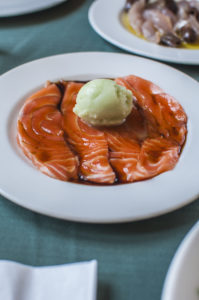
The menu changes daily and is reflective of seasonal offerings, with an innovative list of fresh fish and seafood based dishes: “Flavors designed to savor together,” as put by Jeremias. “I approach cooking the same as I do life, with the flexibility to change route with ease. It’s an important concept at the restaurant as our menu is heavily dependent on ingredients from the sea.”
Dishes begin to fill the table – a creamy mushroom bisque served in a cappuccino cup, the intoxicating flavors a result of a lengthy boil; bruschetta bites piled with smoked eggplant cream and Spanish mackerel; a plate of freshly sliced sashimi salmon, stained with soy sauce and topped with homemade wasabi sorbet, a revolutionary union of tastes; and caramel baby St. Peter’s fish with sour beetroot, a devilish play of sweet and savory flavors.
It seems Jeremias’ cooking is a direct reflection of his personality, void of ego and a result of direct surroundings. “It’s important to maintain your sense of self and live life without fear. No one wants to experience their days as a green banana, un-ripened, unfulfilled in purpose and value.”
We sample even more: salmon panko wrapped in Nuri seaweed with fragrant pickled fennel; ceviche of sliced fish, marinated in olive oil, lemon, capers and onions – a simple, yet superb marriage. Finally, the seared tuna with yogurt and olive oil, succulent chunks bursting with zest, enhanced by the sour tang of yogurt; a triumphant experimentation in taste and presentation. The food is a revival of back to basics, ideal for seekers of unfussy dining with a twist.
Our group is then ushered into the modest kitchen, where we gather to watch Uri himself cook our trout. The dish is the only constant fixture on the menu since the restaurant’s opening and is prepared with a generous dusting of freshly ground four season pepper and tossed onto the sturdy iron caldron. A creamy sauce of spices and green onion sizzles as it marinates through the fish, a no fuss process. Yellow rice is added, soaking into the sauce and adding a layer of texture. “It really is that simple,” exclaims Jeremias, as he brings the dish back to our table. “It’s a case of trial, error and fine tuning in concocting the maximum taste from these ingredients.”
Dessert is also by demonstration in the second of the two kitchens, an intimate space filled with the bustle of diligent staff. Warm sugar water is drenched over the baking Knafe, immersing the pistachios and layers of shredded wheat with a syrupy finish. The treat is offset by intriguing rose and cardamom flavored ice creams and a reviving bowl of kiwi soup – minimalist yet intense in taste.
“I don’t follow trends, not in how I dress and not in how I cook. I use simple ingredients for maximum taste and tune my attention into creating quality food,” explains Jeremias. “I don’t think too much, I prefer to throw caution to the wind as overthinking leads to less risk taking. Ultimately, it’s this type of behavior that brings about the greatest satisfaction and appreciation for life.”
The Efendi Hotel: A Night at the Palace
At the core of Acre’s Old City sits the Efendi Hotel, a breathtaking boutique hotel, which resides in a structure dating back 1500 years. During the 19th century, the Efendi houses served as palaces for wealthy Ottomans and were later purchased in 1870 by Uda Hamar, who transformed it into a sprawling family home for his wives, children and servants. Laying abandoned years later, the decrepit building was purchased by Uri Jeremias, who embarked on an eight year labor of love to restore the two adjoining ancient houses to their prior glory. The project, completed in 2012, was painstakingly intricate, following a detailed plan, which adhered to the guidelines of the local Antiquities Authority. The result is quite remarkable, merging an old world charisma with present day appeal.
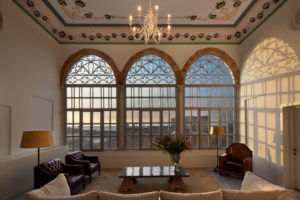
“Each ceiling mural was hand painted by a team of Italian artists over an eight month period, which required the highest level of skill, concentration and attention to detail,” says general manager Roi Samogora. The result is captivating, an assembly of lively flowers, accented by gold trimmings, each room incorporating a unique design. The entire hotel is unified in character, with its palatial elegance evident across many elements: the restored marble flooring, ornamental furnishings, artistic windows and eye-catching wall murals. “The whole process of restoration took a lot of patience but the outcome is a one-of-a-kind hotel, which offers a new level of boutique luxury to Israel,” explains Samogora.
The expansive property has a grand dining room, leading off from the entrance level public lounge; an underground wine bar encased in 900 year old arches and remains from the Byzantine Empire; a 400 year old restored Turkish Hammam and a spa. The open spaces are evocative in design and welcoming features, from an oversized chess board to abundant floral arrangements. The hotel is a paradise of ancient grandeur, a one-of-a-kind property for authentic Middle Eastern immersion.
Scouring the property, you feel encased within a story transcending centuries, as if you are residing in a revived palace. Twelve regal rooms exude a distinctive charm of romantic opulence, including Our Presidential Suite, with its exuberant display of high ceilings, lavish furnishings, majestic chandelier and a neutral color scheme; offset by a ceiling of radiant colors. A chic bathtub rests majestically by the back corner window, its floating silver taps and elegant claw-foot legs beckoning me for an afternoon soak, and a succession of rectangular windows draped with fine sheer curtains frame exquisite snapshots across Acre’s shore.
All rooms open directly onto one of either: the plush salon, stately drawing room or outdoor terrace, featuring comfortable floor cushions for an afternoon haven of relaxation. We are especially impressed with the happy hour on the upper deck, where a group of us join to sip on a glass of wine and swap stories of the day, amid the blending colors of sunset. “Our attention is always focused on providing the highest quality of service and making sure our guests are welcome in the hotel and this magical city,” says Samogora. “Everyone should feel at home at all times, you can see this across the layout of the hotel, aspects designed to encourage interaction among guests.”
The following morning a group of us gather for an intimate breakfast around the spectacular knight’s table. Eggs are prepared to individual order from a delectable menu and are presented alongside a sprawling feast of freshly baked bread, a spread of dips, finely chopped Israeli salad, yogurt with sweet granola and delicate pastry delights. Surrounded by an air of royal elegance, we fully revel in the moment. An unparalleled indulgence within the ancient streets of Acre.

“India has always been a major source market for us. We have been welcoming thousands of Indian travelers each year. In 2023, 41,800 tourists from India visited the country and 3.1 million tourists were welcomed from around the world”.
Israel has been distinguished as a party destination and exploring new cities for Indian travelers. Amruta Bangera, Director of Marketing, Israel Ministry of Tourism (India), says that “India has always been a major source market for us. We have been welcoming thousands of Indian travelers each year. In 2023, 41,800 tourists from India visited the country and 3.1 million tourists were welcomed from around the world”.
Bangera elaborates, that Israel is the destination for bachelorette parties: “We get groups from across the world who indulge in the 24×7 city that Tel Aviv is, just like Mumbai”. However, she explains, “From the north to the south in Israel, travellers can experience snow and deserts. And Indians have an added advantage as airlines have restarted operations to the country, after they had halted services following the conflict in Gaza”.
When asked, what are the experiences Indians should not miss in Israel? She says, “Beach buffs, nightlife lovers, history enthusiasts can enjoy themselves with the host of options available. Moreover, she highlights, desert safaris are unique and none like Israel can be experienced elsewhere in the world. On similar lines, Israel is calling on Indian travellers to make memories of their journeys across Israel”.
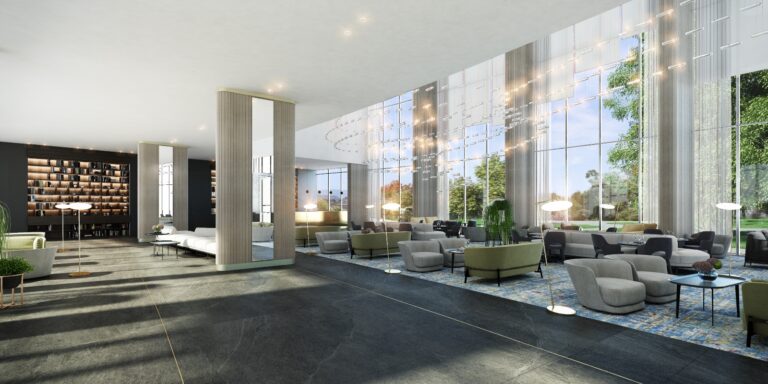
Quite a number have opened their doors in the last six months, ranging in style from uber designer to minimalistic. Here are some of the new hotels in various locations throughout Israel.
The George, Tel Aviv
With the internationally renowned Spaniard, Lazaro Rosa-Violan, behind the stunning interiors and 1,000 artworks curated by Tel Aviv’s Gordon Gallery, The George is a contemporary design statement. It has 130 rooms, 40 suites and junior apartments designed for extended stays. The property, opened in February, bills itself as a lifestyle hotel where guests can experience the “SevenEx – seven urbans experiences of live, work, meet, celebrate, dine, stay and relax”.
This also extends to the Friends of George Member’s Club, which includes a curated program of culture, music and lectures. You can only become a member with recommendations from two current members and a monthly membership fee. The George is situated a few minutes’ walk from Rothschild Boulevard, which puts trendy restaurants, galleries and Habima Square in close proximity.
Amenities: 24-hour front desk and concierge service, Pardes Restaurant (not kosher/open to the public), The Lot (breakfast-lunch-dinner for club members and hotel guests), Jazz Hall live music lounge, event space, workspace, outdoor swimming pool with deck bar, wellness floor (spa, treatment rooms, Pilates lessons), dry and wet sauna, fitness center with personal training, free underground parking.
Address: 5 Tal Street, Tel Aviv
The Almond Hotel, Neve Ilan
Opened in February by C-Group Hotels, The Almond is a luxury adults-only boutique hotel situated in a pastoral area halfway between Tel Aviv and Jerusalem. The style of the hotel is contemporary chic with emphasis on original Israeli art. Artist Tzachi Nevo, creator of the UMASQU brand of playful, colorful cutout figures and shapes, adds to the aesthetic in the reception area, on room walls and hotel signage.
The rooftop pool is the place to relax with its view over mountains and the coastal plain. If you want to swim in privacy, there is the option of a room with an adjacent pool (a rare find in Israel). Amenities: The View Restaurant (continental, vegetarian, vegan, gluten-free, kosher buffet breakfast offered), outdoor swimming pool, spa/wellness center, sauna/hot tub, hammam, facilities for disabled guests, free parking.
Address: Ha-Shayara Street, Neve Ilan
Albi Florentine, Tel Aviv
The Albi fits perfectly into Florentine, the hipster neighborhood known for artistic vibes, cafés and bars. In keeping with the modern, young vibe, the hotel does not have a traditional reception desk and check-in is done digitally.
After running around the urban jungle, guests can relax on the rooftop which has a Jacuzzi, sunbeds and lounge chairs in vibrant ochre colors. There is a beautiful wall mural too. The hotel, opened in March, is near Levinsky Market’s spice stores and ethnic eateries, and Alma Beach is 1.5 kilometers away.
Amenities: Family rooms, shared lounge, kitchenette/dining area, concierge service.
Address: 29 HaRav Yitzhak Yedidya Frenkel Street, Tel Aviv
Rothschild 69, Tel Aviv
Classic luxury is how this hotel can be described. Housed in a historic International (Bauhaus) style formerly residential building that dates back to 1932, Rothschild 69 opened in November after having been beautifully preserved and brought back to life.
The rooms have contemporary furnishings and an eclectic style with large windows and wide balconies. For those who want to indulge, a champagne/wine room service is available. For nearby shopping, there’s Sheinkin Street with its boutiques and cafés.
Amenities: Fridge, dishwasher, microwave in certain rooms; garden; wine/champagne room service available; breakfast till midday; lounge with light menu; restaurant serving fish, seafood and vegetarian specialties; parking available at a sister hotel five minutes’ walk away.
Address: 69 Rothschild Boulevard, Tel Aviv
David’s Harp Galilee Resort Hotel, Emek Hayarden
At an investment of 300 million ILS, the 4-star David’s Harp hotel is scheduled to open shortly. It’s architecturally designed to appear as if it’s a harp growing out of the ground. The hotel has 276 rooms including 18 suites and two presidential suites.
David’s Harp is next to the only floating dock operating on the Sea of Galilee where picturesque wooden boats take pilgrims out onto the lake. The location is in the heart of Christian sites and the Israel National Trail. The interiors are clean and minimalistic, using local basalt stones and natural textures with glass walls that bring nature inside. An infinity pool (heated in fall and spring) overlooks the blue waters of the Sea of Galilee.
Amenities: Lobby restaurant, business lounge, event halls, meeting rooms with advanced audio and video infrastructure, amphitheater for 650 guests overlooking the lake and surrounded by mountain scenery, spa, gym with running and cycling tracks, heated outdoor pool, parking.
Address: D.N. Emek Hayarden
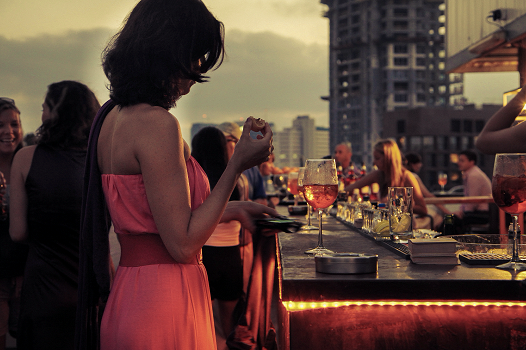
December 31st will mark the end of a decade, and what a decade it’s been! Many are ready to bid adieu to a tumultuous ten years, and usher in a new era. Venues all across Israel are getting creative about how to ring in the twenties; the following is a roundup of the best action from Akko to Jerusalem and everywhere in between.
Jerusalemites should spend the night at the Mirror Bar at Mamilla Hotel, where the city’s top DJ, Raz Yosef, will be spinning all night long. Enjoy specialty New Year’s Eve drinks and dishes, unwind in the exclusive cigar bar, and start off the the new year at Jerusalem’s chicest nightlife address.
What better way to ring in the roaring twenties than with a Gatsby themed bash? Brown Hotels is continuing in its tradition of over-the-top New Year’s Eve events with a Gatsby theme party at its flagship Tel Aviv property, Brown TLV. Decadence will rule the night, so come dressed to impressed. Tickets are already on sale, and rooftop VIP packages are available.
For a real dose of holiday cheer, head north to Akko where the incomparably intimate Efendi Hotel is planning a New Year’s Eve dinner in its 19th century wine cellar, in collaboration with Golan Heights Winery. The four course meal will be prepared by Uri Jeremias, the chef and owner of Akko’s iconic fish & seafood restaurant Uri Buri. Each course will be accompanied by a different varietal, with a pairing explanation provided by a representative from the winery. The dinner is 350 NIS a person and space is limited, so call the hotel now to reserve. Efendi Hotel has sweetened the deal with an end-of-year, 15% discount on its Royal Rooms and Presidential Suites, so stay overnight and start 2020 at Israel’s most stunning boutique hotel.
Vegans rejoice! Tel Aviv’s pioneering vegan cafe, Meshek Barzilay, has prepared an indulgent, plant-based wine pairing menu to celebrate the night. From Coconut Curry Mushroom Soup to house-made ravioli with a root vegetable ragu, the organic menu is a celebration of the plant kingdom’s many riches. Each course is paired with an exceptional Israeli wine. The dinner begins at 300 NIS for two people, call the restaurant directly to reserve.
For an evening filled with elegance, head to Tel Aviv’s peaceful Germany Colony neighborhood and enjoy a meal at The Drisco Hotel’s award-winning George & John restaurant. Chef Tomer Tal, recently named Tel Aviv’s most exciting rising star chef by prestigious French culinary guide Gault & Millau, has conceived a special menu to mark the occasion. Guests will be treated to the musical stylings of DJ Edward El Camino from 18:00 – 1:00. Space is limited so call The Drisco to reserve your place.

Israel is known of course for its fantastic beaches and sunny weather and there is nowhere better to be than outdoors whether it is in the Golan, Galil, Tel Aviv, Jerusalem, the Dead Sea, the Negev Desert or Eilat.
The winter months are no different and as long as the weather is good, there is plenty to do. For instance, in December, the Israel-Ethiopian Arts Hullegeb Festival brings together traditional Ethiopian culture in theater, dance and music, with Israeli and Western culture. The festival features theater, concerts and dance performances.
The Hirus Ultra Marathon (HUM), also in December, was created to share the sense of freedom when running in the fields, forests and mountains and along the springs and paths. The name “Hirus”, which means “holy” in Greek, is one of the ancient names of Jerusalem and emphasizes the connection between the city and nature.
The two flagship festivals of the winter in Jerusalem are “Hamshushalayim”, usually in December, and “Sha’on Horef” in February, as noted by iTravelJerusalem. Both last an entire month and involve countless concerts, lectures, exhibitions and more. There are also numerous other smaller festivals throughout the season.
Throughout December, Jerusalem hosts a film festival showcasing various genres and themes. The performances provide an artistic perspective on culture, art, music, dance, people’s lives, etc. Apart from this, Israel also hosts many other festivals during January and February.
Hanukkah (the night of December 22 – 31) is the eight-day Jewish holiday celebrating victory over the Greek empire over 2,000 years ago. Every night, for eight nights, the city lights up with “hanukkiyot” (menorahs) in just about every window, and there are public lightings all over town. Walk along the alleys of Jerusalem’s Old City or Nachlaot neighborhood to see the hanukkiyot lit inside glass boxes on windowsills, or join a public lighting at the Mamilla Alrov Mall and the Western Wall. You’ll also find tons of special events around town and delicious (albeit unhealthy) filled doughnuts called “sufganiyot” in almost all the bakeries.
Jerusalem is also one of the best places in Israel to celebrate Christmas, as the Old City comes to life with celebrations, concerts, church services and much more. It’s also only a short trip from Jerusalem to Bethlehem, the scene of the nativity, and there are some great Christmas tours to take you there. The tens of thousands of Christian tourists who come to Israel every December also find seasonal events taking place from Haifa’s annual month-long Holiday of Holidays extravaganza to the Christmas parade in Nazareth.
New Year’s Eve isn’t the big party in Israel that it is elsewhere, but it’s a great opportunity to take advantage of the indulgent menus at some of the fine-dining establishments or cafés around town. Israelis, like many Europeans, call the secular New Year’s Eve “Sylvester,” taken from the name of the pope whose death on December 31 was traditionally marked with a feast. Since midnight December 31 is not a Jewish milestone, you won’t find Sylvester parties in any kosher-certified establishments in Israel. But many bars, clubs and pubs in Tel Aviv and Jerusalem throw celebrations.
If enough snow falls, there’s only one place to ski in Israel, and that is Mount Hermon at the northern tip of the country. Rising 9,230 feet above sea level, Mount Hermon has a vertical drop of just 1,552 feet, making it ideal for beginner and intermediate skiers. Tubing and sledding are also available.
As Israel21c notes, “Israel’s Beit She’an Valley is consistently cited as one of the top 10 hottest places on Earth, with temperatures reaching as high as 53.9C/129F. That’s why many tour guides recommend planning your exploration of the expansive archeological site in Beit She’an National Park for the winter months. An earthquake in 749 CE left behind ruins of grand colonnaded streets, a bathhouse, theater and shrines, all of which Israel’s Antiquities Authority reconstructed.”
But when winter sets in, mild as it is compared to Moscow or Maine, the occasional strong winds and driving rain will make it necessary to find indoor entertainment.
Tel Aviv has several shopping malls, each with its own history and personal touch. Dizengoff Center extends over several buildings. There are large international brands, Israeli brands and food stands. The Azrieli Center is a huge shopping mall that extends over 3 floors: fashion, food, house, lot of fast food and restaurants. Ramat Aviv Center has a mix of luxury shops and international brands.
There are numerous museums situated around the country, covering everything from art, history, science and more, according to iTravelJerusalem. “Of course, there’s the massive, world renowned Israel Museum, but don’t forget some of the more specialized institutions like the Bible Lands Museum, Bloomfield Science Museum and L.A. Mayer Museum for Islamic Art, where you can get a deeper understanding of specific topics.”
The Museum of Islamic Art in Jerusalem has a terrific exhibit on Andalusian art in the Middle Ages. According to the museum’s website, “The exhibition presents gleaming Spanish vessels made of gold, ivory and jewelry, colorful tiles used to decorate the Alhambra and the homes of the Christian aristocracy in the Mudéjar style (featuring Muslim and Christian elements). This was in addition to illustrations in manuscripts (copies) of the Koran, the Bible, the Byad and Ryad novel and Christian psalms that document the religious ritual as well as day-to-day life between the Muslims, Jews and Christians in Spain.
“The Andalusian and Mudéjar artifacts and manuscripts are exhibited against a backdrop of illustration of the Mosque of Cordoba, the Alhambra palace and the Jewish synagogues of Toledo that convey the Andalusian “arches language” which resonates in the music and poetry performed at venues of Caliphs and those who loved the art form.
“The Andalusian Golden Age depicts the blossoming of relations between Jews and Muslims, which produced fertile ground for rich cultural growth.”
The famed Israel Museum in Jerusalem has a terrific exhibition from December 16 through October 2020 and titled “Emoglyphs: Picture-Writing from Hieroglyphs to the Emoji.” As described on the museum’s website, “The hieroglyphic script that developed in Egypt some 5,000 years ago comprised hundreds of pictures. Over time, the pictures were replaced by a writing system consisting of approximately twenty signs: the alphabetic script that reigns in Western culture to this day. Picture writing appeared to have been abandoned forever, but in the digital 21st century, the picture – namely, the emoji – has returned in full force. This exhibition presents the metamorphosis of picture-writing from antiquity to modern times through a wealth of finds from ancient Egypt, displayed against the background of contemporary emoji use.”
Designed by American architect Preston Scott Cohen, the Tel Aviv Museum of Art’s fascinating architecture alone will keep you wandering for hours. The museum is made up of various departments such as the Department of Israeli Art and the Department of Prints and Drawings. In addition to its extensive program of permanent and changing exhibitions, the museum offers a vibrant selection of programs and activities for adults, youth and children: concerts, classes, lectures, guided tours, workshops, and more.
The broad choice of music in Jerusalem is a bit of a secret, but winter is the perfect time to enjoy a concert in an intimate indoor venue – and there are plenty. The Jerusalem Symphony Orchestra boasts musicians who have immigrated from all over the world and perform regularly. If you’re looking for jazz, rock and other contemporary music, the Yellow Submarine has a concert almost every evening. You can also find free shows at bars like Mike’s Place, Ha-Mazkeka (Shushan Street) and Birman.
You know winter’s here when you see renderings of piping hot bowls of soup in every Jerusalem eatery, and it helps ease the pain of summer’s end. The most popular soups around town are probably tomato with vegetable, lentil and of course, Jerusalem’s famous kubeh soup, but if you’re looking for some more exotic flavors try Hamarakiya, a quaint restaurant that specializes almost exclusively in vegetarian soups. The Inbal Hotel also features a terrific soup night in its lobby.
The Eilat Israman full and half distance triathlon takes place this year from January 29 to February 1. Known as one of the 10 most challenging triathlons in the world, you can participate in this great event, including both half and full triathlon distance triathlons. The event is held in the resort town of Eilat, Israel, and will welcome thousands of international and national participants.
Following tradition, on the morning of Saturday, February 1, 2020, a day after ISRAMAN-EILAT, on the same beach, the annual International Red Sea SwimCup will take place.
The International Red Sea SwimCup is the only winter open sea swim race in the northern hemisphere, and is made possible due to the pleasant winter temperature in the Gulf of Eilat, on the northern tip of the Red Sea, and which is world famous as the premier open-water sea swimming venue on the planet. The regal red mountains, the enchanting sunrises and the majestic sunsets, provide the ultimate backdrop for a perfect swim in the calm deep-blue waters.
The Western Galilee Now Association, which promotes tourism and leisure in the region of the Western Galilee, has for the eighth consecutive year held the “Western Galilee Winter Festival”, a three-day festival, which includes all the good that the Western Galilee has to offer.
The unique festival offers a meeting with artists, winemakers, cheese makers, chefs, musicians, mentors, craftsmen, women and artists who together create a wonderful world in the Western Galilee. You can come for one event or put together a weekend getaway that includes some of the festival days and multiple events.
In addition to the above mentioned events and activities, there is of course the option of just kicking back in a café with a hot cup of anything or going to the movies. On non-rainy days, the weather is usually pretty agreeable and suitable for visiting sites or doing activities that are too hot in the summer.
No matter what you choose to do, make it a great experience and enjoy Israel’s Middle Eastern winter!
December 2019 Events in Israel
1-31: Jewish Film Festival, Jerusalem
1-7: International Photography Festival, Tel Aviv
4-6: The Jerusalem Jazz Festival. Jerusalem
6-7: Jacob’s Ladder Festival, Sea of Galilee
17-22: Christmas Market, Nazareth
18-20: The Tel Aviv Jazz Festival, Tel Aviv
19-28: Holiday of Holidays, Haifa
20: Run the city Marathon, Tel Aviv
20-22: Winter Christmas Festival, Western Galilee
21: Jim Jeffries Live in Tel Aviv
23-31: Hanukkah
24: Christmas Eve Tour
25: Christmas in Israel
31: New Year’s Eve, also known as Sylvester

“Theodor Brown is a hotel that truly honours Brown Hotels primal ethos of creating unique, boutique hotel experiences, imbued with a sense of place. Due to the building’s heritage and location, Theodor Brown is a very special hotel and a testimony to Tel Aviv’s rich cultural and architectural history, making it one we’re quite prou
International hotel collection, Brown Hotels presents the latest addition to its growing portfolio of properties, Theodor Brown, a Bauhaus-inspired, 34-room boutique hotel situated on the corner of the bustling Rothschild Boulevard. The property was originally due to launch in spring 2020, but stalled due to the COVID-19 restrictions with the building being repurposed in the interim. Having now officially launched, Theodor Brown marks Brown Hotels’ 23rd hotel in Israel, boasting 34 comfortable rooms, a vibrant Italian restaurant by Chef Tomer Agay, and a sophisticated interior decor by Israeli architect Kedem Shinar; a true homage to the Bauhaus era.
Originally built in 1935, Theodor Brown inhabits a traditional Bauhaus property at the intersection of Herzl Street and Rothschild Boulevard, situated amongst some of Tel Aviv’s most popular restaurants, nightlife and cultural destinations. Designed to offer guests a cosy yet refined urban bolt hole in the beating heart of the city, the charming boutique hotel combines architectural history, contemporary design and superb local and in-house amenities, for an unbeatable Tel Aviv experience.
Leon Avigad, founder of Brown Hotels, said “Theodor Brown is a hotel that truly honours Brown Hotels primal ethos of creating unique, boutique hotel experiences, imbued with a sense of place. Due to the building’s heritage and location, Theodor Brown is a very special hotel and a testimony to Tel Aviv’s rich cultural and architectural history, making it one we’re quite proud of.”
A tribute to modern minimalism and Bauhaus principles, the original building was developed by architects and engineers Yosef Kashan and Elisa Shimshoni and has been preserved by virtue of the Conservation Plan 265ob. Inspired by the property’s facade, the hotel’s interiors present a contemporary take on classical Bauhaus design led by architect Kedem Shinar. Rooms at Theodor Brown showcase vivid green ceilings with contrasting black and white wall detailing as a nod to the ‘White City’ and its deep, architectural roots. Complete with herringbone wood flooring, geometric shapes, sleek lighting fixtures, brass and rattan detailing and Bauhaus inspired posters, Theodor Brown presents an inspiring urban retreat for the discerning and culture-seeking traveller.
With 34 contemporary designed rooms and suites, Theodor Brown boasts five room types to choose from including the Solo Room, Classic Room, Deluxe Room, Terrace Room and Studio. Terrace rooms are located on the top floor of the hotel with Bauhaus-style balconies and outdoor sun-beds and a dining table for two, while the studios can comfortably accommodate families with indulgent king size beds and double sofa beds. Each room at The Theodor is fitted with a fully stocked mini bar (excluding Solo Room), Nespresso coffee machines (Terrace, deluxe and studio rooms only), 100% Egyptian cotton bed linens, work desk and chair, HD TV with satellite television, laptop safe, waterfall showers, bathrobes, slippers and pampering toiletries by Molton Brown.
At the heart of the hotel is CENA restaurant by renowned Israeli chef Tomer Agay of the popular Santa Katerina restaurant in Tel Aviv. Taking guests on a gastronomic journey, Agay’s dishes combine the tastes and traditions of Southern Italy, Tunisia and Israel, coupled with delicate, local and Italian wines and punchy, piquant cocktails. Stand-out dishes include shrimp skewers on amba tahini with charred onions, organic broccoli and garlic confit, Jerusalem artichoke grilled in a tabun oven, with white wine, parmesan, garlic, butter and a tangy tomato sauce, and roasted veal fillet with spiced aioli and crispy leaves, served on bruschetta with capers and pickles. Home to a buzzing bar, open pizza oven, a clean and contemporary interior aesthetic and a picturesque courtyard with marble detailing and a warm gold and green colour palette, CENA welcomes guests to enjoy breakfast and dinner.
Theodor Brown officially opened in September 2022 with rooms starting from 1,126 ILS (currently approx. £256) per night on a B&B basis.
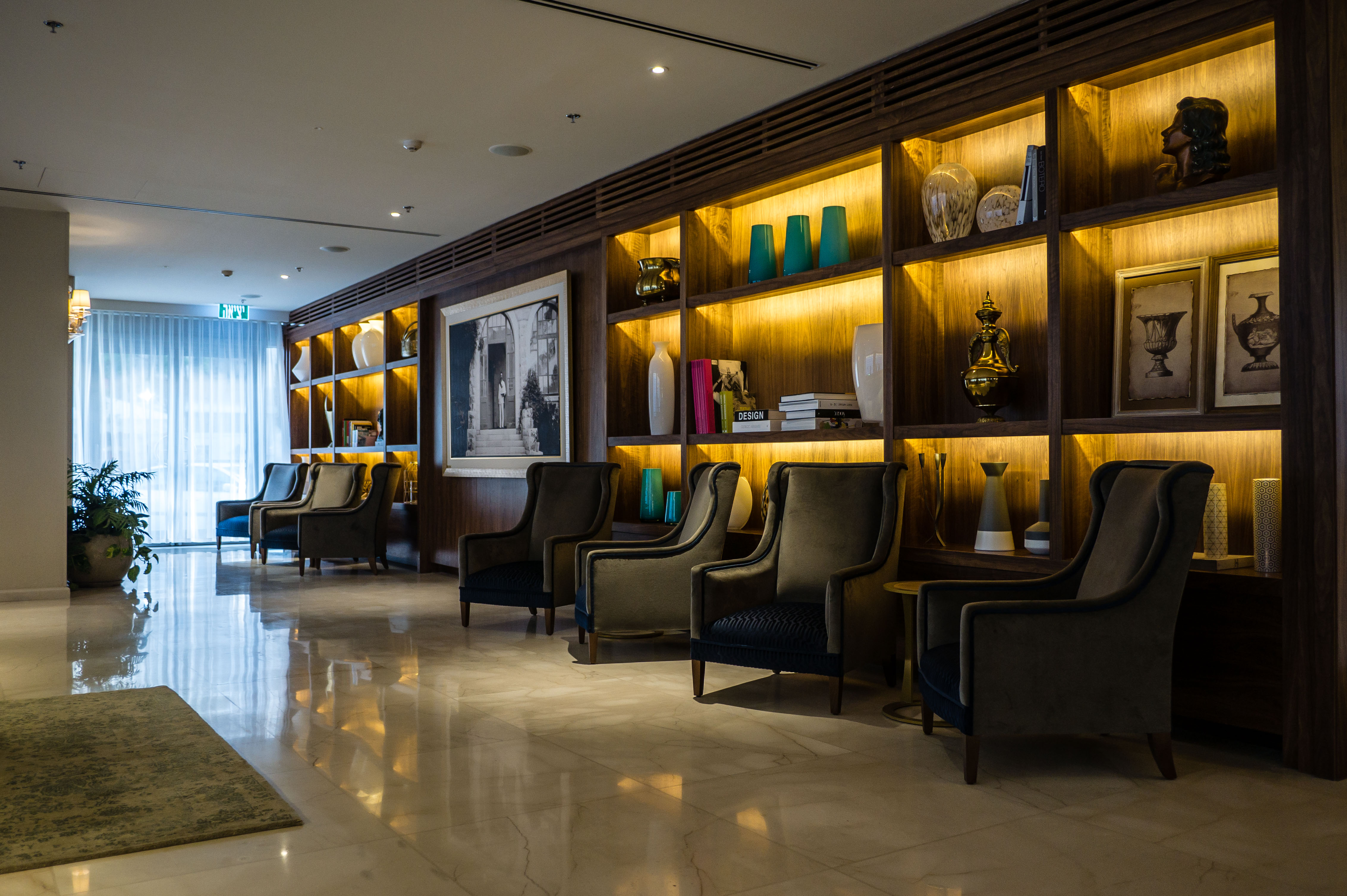
3The Herbert Samuel Hotel, a property of Nakash Group Israel, opened its doors in the summer of 2016. The building, previously a hotel which had lain abandoned for eight years, underwent a two year renovation to re-open as a luxury hotel encompassing a European Style. “We are situated in a prime location in the center of Jerusalem, close to transport links and major tourist sites,” says General Manager Danny Bukovsky. “We pride ourselves on presenting outstanding quality and service, with every request attended to by our team of dedicated staff who are happy to assist.”
The striking lobby lounge welcomes you with an inviting fresh scent, and is meticulously designed in a palette of gold, brown and blue fusions. The classic wooden bar displays illuminated stacks of alcoholic beverages, a welcoming spot for an evening tipple.
The hotel contains 137 rooms across a mix of Superior Rooms (18-22m²), Deluxe Rooms (28m²) and four 40m² Suites which include a living room. My ninth floor Deluxe Room is as elegant as they come, a divine blend of neutral tones, silver accents and luxurious marble flooring. Leather bound furnishings and a comfortable seating area enhance the room’s aesthetic, as does the crème de la crème rainfall shower – traditional sophistication fit for the present day. Resting on the indulgent king size bed, it becomes clear I’m in for a tranquil night’s sleep.
Spa & Health Club
I awake early the following morning for a pre-breakfast swim in the indoor pool, located in the health complex which features a spa, gym and dry and wet saunas. I’m fortunate to enjoy the pool to myself, which is surrounded by groups of lounge chairs and a comfortable seating area. “We are one of the few hotels in Jerusalem to provide an indoor pool, which is heated to 28 degrees year round. Our gym is open 24/7 and our guests have the benefit of booking from a wide range of indulgent spa treatments provided by our professional team,” outlines Bukovsky. The setting is elegant, with atmospheric lighting that enhances the water’s reflection as it shimmers from the golden ceiling.
Breakfast With a View
Breakfast at the Herbert Samuel is, in itself, an experience. The 11th floor restaurant presents a spectacular 360 degree view across Jerusalem, amid atmospheric music that sweeps across the classic space. Guests, who dine under an intricate gold iron ceiling imported from the Netherlands, are permitted a behind– the– scenes glimpse of chefs at work from the open plan kitchen.
The banquet of cuisine is a feast of many cultures – including a Balkan Shakshuka, seasoned in tasty spices, and an irresistible melt-in-your mouth Knafe. Rows of colorful chopped vegetables, and dressings, antipasti, eggs, mountains of cheeses, fresh and dry fruits, cereals, breads, pitas, bagels and sweet treats, including pastries and halva slabs, are stationed across the room – a winning presentation of Middle Eastern delights to cater to all tastes. I chose a table encased within the glass terrace which offered an idyllic backdrop of the spectacular city, the perfect accompaniment to my morning Shakshuka.
The Market & Business
The hotel is also popular among business guests and provides a choice of two conference rooms, which can seat up to 14-24 people. “Our incoming market consists of 70 percent Americans, 20 percent Europeans and 10 percent from Asia, and our occupancy for 2017 sits at around 55 percent, but we are confident this will increase next year to reach around 65-70 percent,” explains Bukovsky. “No matter what your intent, our mission is to ensure the most pleasurable of stays, across every aspect at the Herbert Samuel Jerusalem.”
Image credit: Itay Sikolski
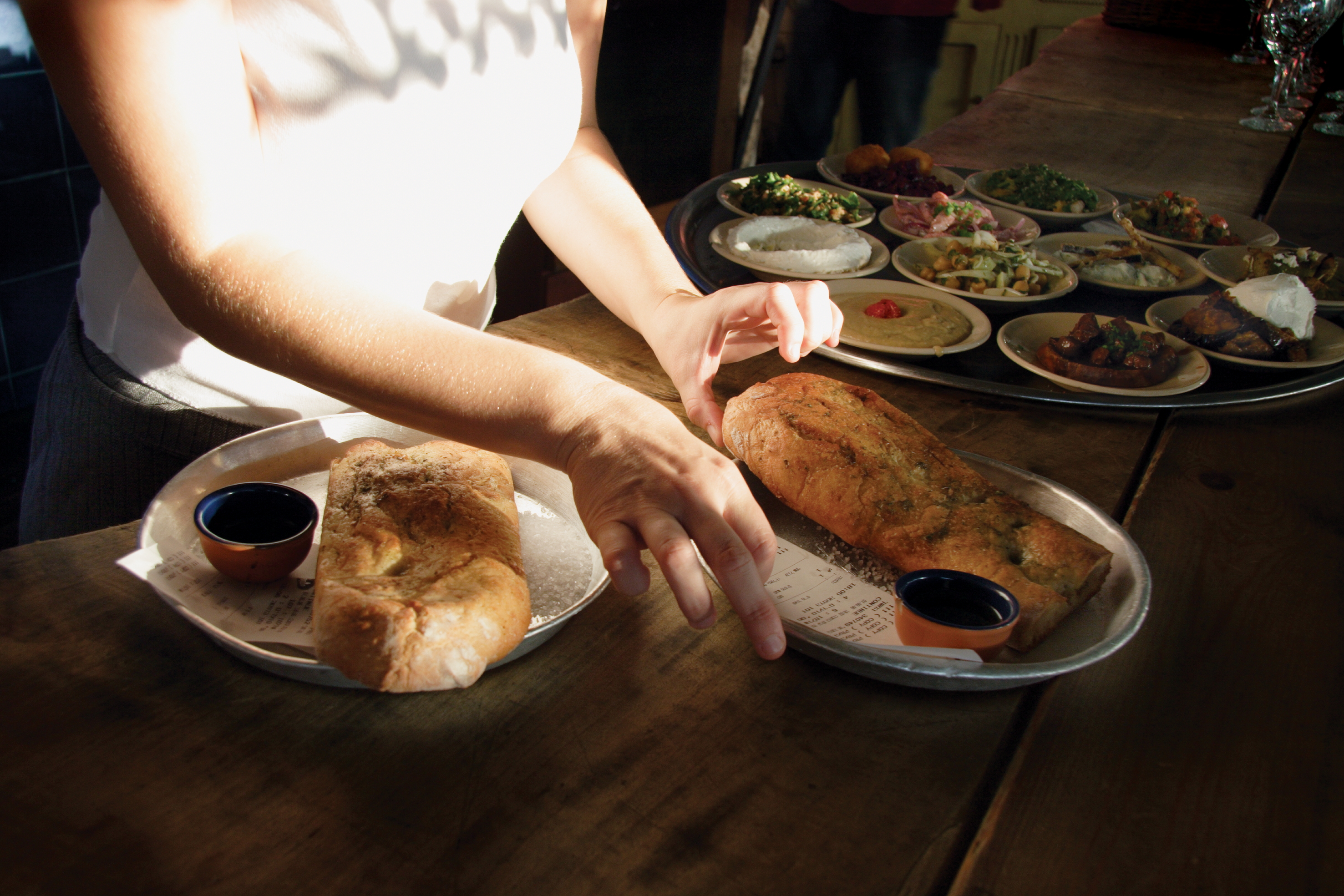
Tel Aviv on Travelandleisure.com
Tel Aviv has been featured on Travel + Leisure’s: ‘The 50 Best Places to Travel in 2018’ list, as voted by travel experts. The piece cites the city’s nightlife, culinary scene, Jaffa Port and Beit Kandinof as places of interest, in addition to mentioning new hotels the Setai Tel Aviv and the W Tel Aviv.
Deezen’s Top 10 Skyscrapers of 2017
Architecture and design magazine Dezeen has featured Tel Aviv’s Meier on Rothschild Tower, by Richard Meier & Partners, on its list of the top 10 international skyscrapers of 2017. The 154 meter-high Bauhaus inspired building is featured in the free White City walking tour run by the Municipality of Tel Aviv, which departs from 46 Rothschild Blvd. every Saturday at 11am.
Miamiindulge.com’s Culinary Tour Through Israel
Luxury lifestyle magazine Indulge has published an article entitled: ‘Holy Land, Heavenly Food: A Culinary Tour Through Israel’, which follows Editor-in-Chief of Indulge Miami, Evan Benn, on a recent trip throughout the country.
The visit included stops in Tel Aviv at North Abraxas, Manta Ray, Shlomo & Doron, Carmel, Rothschild Allenby and Sarona markets, and culinary touring company Delicious Israel. North of Tel Aviv included stops at Tishbi Winery and a Druze village on Mount Carmel. In Akko, Benn dined at Uri Buri; and in Jerusalem visited Mahane Yehuda Market, the Open Restaurants urban culinary festival, a Women and Tales in Jerusalem Project gathering, and restaurants Eucalyptus, Mona and Machneyuda.
Apart from the culinary scene, the article focused on other points of interest: Fashion house Maskit, Israel Museum, The Old City of Jerusalem, Tower of David Museum, the Baha’i Gardens in Haifa, and Caesarea National Park, in addition to hotels: The Efendi Hotel in Akko, and the David Citadel and Mamilla in Jerusalem.
Efendi Hotel wins Luxury Travel Guide Award
The Luxury Travel Guide, a provider of travel and lifestyle related news, has selected the Efendi Hotel in Akko as ‘Historic Luxury Hotel of the Year’ in its 2017 awards. The winners, which are awarded in national categories, are selected by a team of travel experts and are intended to recognize specific luxury tourism sectors across the industry.
Israel on forbes.com’s Food and Restaurant Trends
Forbes has published an online article outlining the ‘Top 10 Food and Restaurant Trends of 2017,’ collected from trend ideas across restaurants in the US, as compiled by culinary experts. “Israeli Flavors” placed number six on the list, which said: “…harissa, tahini, feta cheese, pomegranate, sesame seeds, labneh, cumin, Baharat seasoning, lamb and savory yogurt sauce are populating all sorts of menus and recipes on cooking blogs.”
Image: Manta Ray
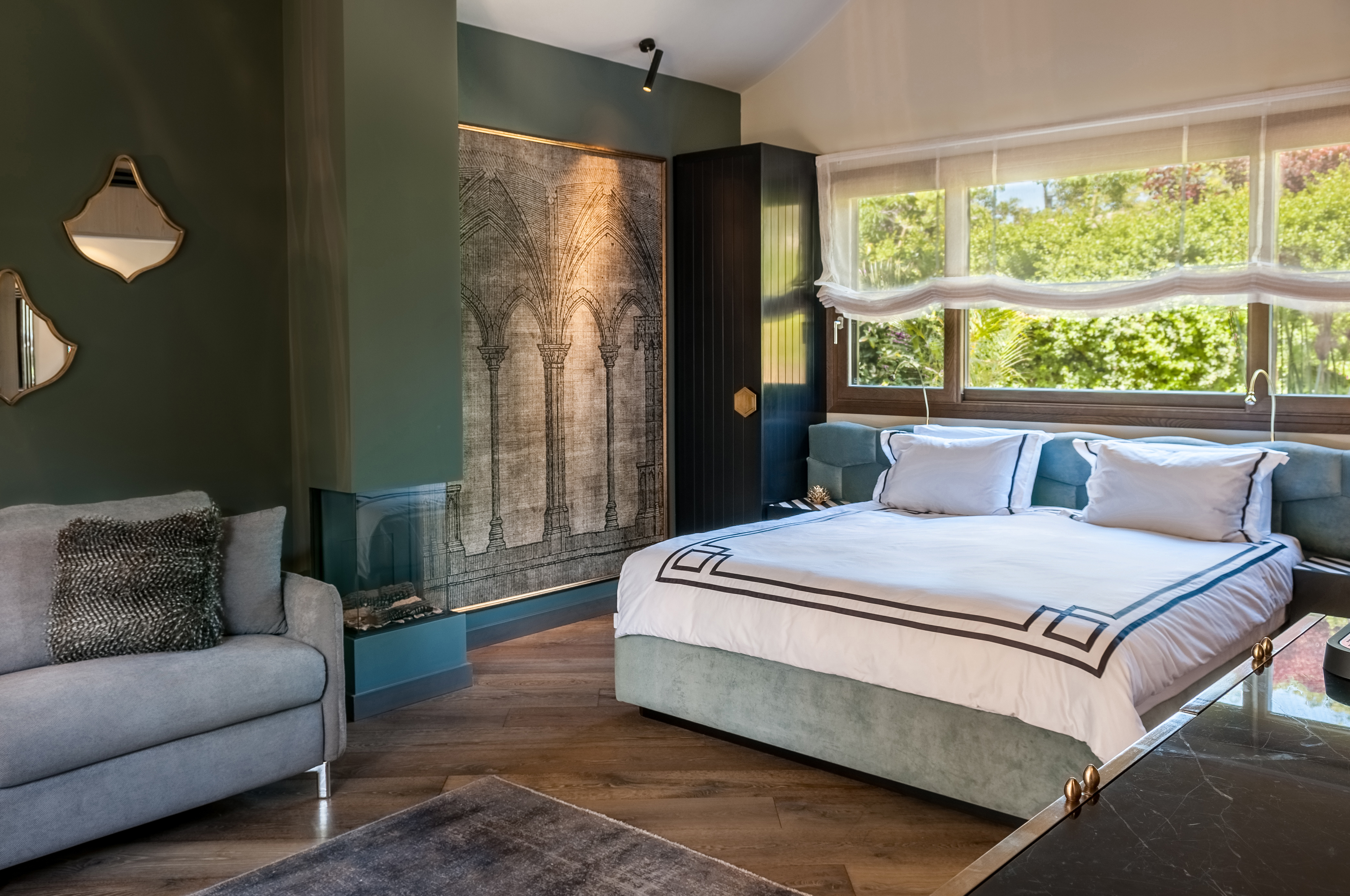
Located on Moshav Liman in the Western Galilee, a short ride north of Nahayria, sits Maskit Boutique, an intimate hotel set within a private estate.
Located on Moshav Liman in the Western Galilee, a short ride north of Nahayria, sits Maskit Boutique, an intimate hotel set within a private estate. The owners, husband and wife duo Avi and Sarit Maskit, opened the hotel in 2006 on a perfectly manicured plot of land, surrounded by landscaped gardens and two lively horses.
“I spent years working in the banking sector and decided to trade in the job not so long ago to run Maskit full time,” says Sarit. “We revived the concept in April 2016, redesigning the rooms and amenities to fulfil our dream of providing an exclusive and luxurious hotel complex in Israel, and we also host events such as intimate weddings and parties.”
Quaint brick paths lead you to four 45m² suites dotted along private enclaves, the entire grounds perfumed by blossoms of gardenia and white roses. “We plan to expand by building a further four suites in the future, two of which will have their own private pool.” Behind an iron gate marked “2” is our suite, Adoria Rosetti, housed within a beautiful structure encircled by a lushness of green and exotic plants.
The suite’s design pays homage to classic 1920s Europe, swathed in gothic hues of black, grey and dark green; a dusting of gold trimmings and eclectic knickknacks offsetting the opaqueness. “Our designer even incorporated elements from nature, such as wood from the trees, into some of the furnishings, including leg stands,” says Sarit. “Our objective is to thread together luxury and nature.” This is evident throughout many features, from the wood-burning fireplace encased in glass; a specially crafted wooden ceiling fan and the black glass cabinet emblazoned with a handsome white horse.
Designed by Roee Yarkoni, the room exudes an opulent elegance fit for royalty – from the custom-made king size bed to the built in glass fireplace and fine furnishings; we felt the indulgence from the first second impression. Flashes of Middle-Eastern influence evoke from the arch-shaped mirrors, hanging lamps and rich wall tapestry. “Most of our furnishings are custom made in Israel and are unique to Maskit,” explains Sarit. Two wooden sliding doors open to reveal a grandeur bathroom, with double marble sink, L’Occitaine branded toiletries, fluffy bathrobe and slippers, art deco tiled flooring, indoor rainfall shower and a small path leading to a clandestine garden shower.
On-site is an outdoor mosaic swimming pool with tanning deck and sunbeds, a secluded round heated pool within a closed walnut wood cabin a spa offering pampering treatments and a dry Finnish sauna. The restaurant and lounge, overlooking the landscaped gardens, captures a timeless European-esque charm, with a shimmering chandelier, plush velvet seating, a grand wood and iron dining table and charming floral print crockery, a page from an interior design magazine.
Breakfast is served directly to the table, prepared by talented young women from a local Bedouin village. Laid before us are: zesty chopped salads infused with olive oil and herbs from the garden; a chopped brown bread loaf; seasoned cheeses; flavorful tuna salad; thickly swirled tahini spread; handpicked farm eggs in any style you desire, and freshly squeezed orange juice. Presented on finely printed china, the cuisine was as healthful as it was satiating.
Our overnight at Maskit boutique was a welcoming respite, with calming music, a serene ambiance, abundance of nature and sweet smells luring us into a state of fine relaxation. All in all, a private escape from city life amid the pristine country.
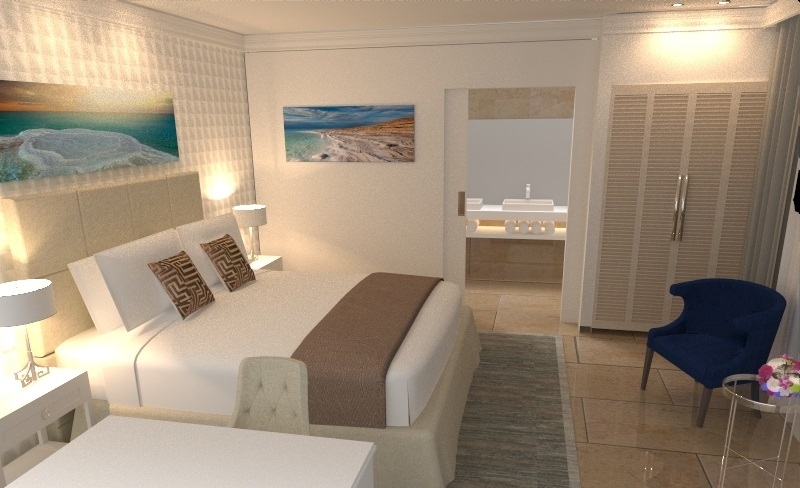
Orchid Hotels has added Milos Dead Sea to its expanding portfolio of accommodations in Israel. In development this year, and slated to open in November, the new hotel is described by Director for Orchid Hotels and Jordache Group, Israel Ran Balbus as a “resort by the beach.” The 162-room property features 128 Deluxe rooms and 32 Suites, 16 of which have a private pool. Each room has its own private balcony, with ground floor rooms offering direct access to the main swimming pool. An infinity pool will also be stationed by the beach.
“The property was previously the Tsell Harim Hotel, which closed two years ago, and we have renovated it into a highend village in the middle of the desert.”The hotel features a spa with 12 treatment rooms, Turkish Hamam and a swimming pool, with a high-tech fitness center available 24/7 for guests. “We chose the name Milos to reflect contemporary Greek style, with a light and casual resort that has a ‘tavern by the beach feel,’ where guests can enjoy the best facilities and indulge in our relaxing environment,” explains Balbus. The dining room, which will house a chef restaurant, is to serve a buffet breakfast and an à la carte dinner menu, among other options. Other amenities include a lobby lounge, where events will take place, and a parking lot. “We are a hotel for anyone wanting to experience the Dead Sea from a new perspective,”says Balbus.
